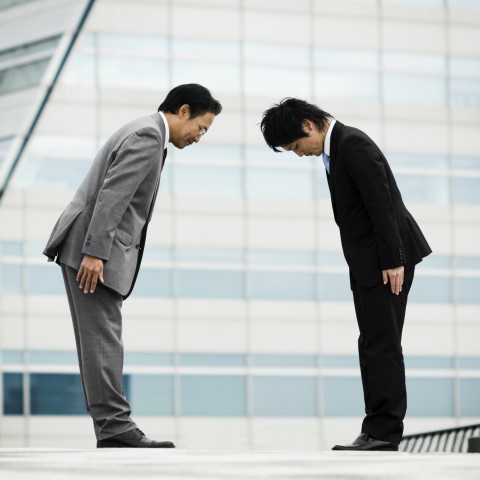
Every culture has its own unique body gestures when speaking to express certain feelings or situations efficiently. Japanese hand gestures and body language are no exception and there are a variety of body gestures in Japan—many more than you’d expect!
Most Japanese body gestures are particular to the Japanese culture and foreign people may wonder what they stand for, or even get the wrong meaning from them. Learning the body language in Japan will not only help you understand the Japanese culture better, but also make you feel more comfortable communicating with Japanese people.
If you’re a beginner in the Japanese language, you can express and communicate much more with Japanese body gestures without lengthy explanation. If you already know much about spoken Japanese, using Japanese body language and hand gestures while speaking will make you look more natural and fluent than you actually are!
Here’s a list of common Japanese gestures and other Japanese body signs. Start with a bonus, and download your FREE cheat sheet – How to Improve Your Japanese Skills! (Logged-In Member Only)
Table of Contents
- Body Gestures
- Hand Gestures
- Face Gestures and Facial Expressions
- Conclusion: How Japanesepod101.com Can Help You Learn More Japanese
1. Body Gestures
1- Bow
Bowing is one of the most important things in Japanese etiquette for any occasion, in both formal and informal settings. It’s also one of the most common Japanese body language gestures. Bowing can represent a number of things, such as greetings, gratitude, and apologies.
1. Bow with upper body to 15 degrees (会釈 [Eshaku]) : [Informal]
– Meaning: Saluting; light greeting; slight bow
– How to do:
From the beginning posture of standing straight and facing toward the person you wish to bow to, bow and tilt your upper body forward 15 degrees. Your eyes are kept on the person you greet. In informal settings, you don’t need to use your hands; however, it’s more polite if you hold your hands in front of you.
– When/where to use:
This light bow or Eshaku is usually used for an informal and light greeting, gratitude, or apology. This is a casual greeting and not a proper greeting. However, this can be used in business settings in some cases. Japanese people sometimes do this even after finishing a proper greeting as a repetition of a proper greeting.
– Example situation:
When you pass by someone you know on the street, in the office, at school, etc., you bow Eshaku and say “Hi” or “Hello.” However, you don’t always need to include the actual greeting words when you greet with Eshaku.
Eshaku: Smile to someone whom you greet as you bow. Holding hands is polite but not necessary in most cases.
2. Bow with upper body to 30 degrees (敬礼 [Keirei]): [Formal]
– Meaning: Respectful saluting; greeting
– How to do:
From the beginning posture of standing straight in line and facing toward the person you wish to bow to, bow slowly and tilt your upper body forward 30 degrees. Make sure you keep your back straight and don’t just bend your head when you bow. As you bow, you naturally look at the floor. Your arms and hands are placed straight along your body, or in some situations such as in hospitality, hands are placed in front your body, covering one hand with the other. This hand position is suitable for women.
– When/where to use:
You use this gesture in formal settings when you greet, thank, or apologize to someone whom you should communicate with respectfully, such as a client, customer, boss, etc. This is a Japanese gesture of respect.
– Example situation:
This bow or Keirei is used when staffs welcome customers at a luxury hotel or restaurant, and when you apologize to your boss for something at work.
Keirei: Make sure your back is not arched when you bow and do not move too quickly.
3. Bow with upper body to 45 degrees (最敬礼 [Saikeirei]): [Formal]
– Meaning: The most respectful saluting; greeting; deep apology
– How to do:
Do basically the same action as Keirei, but in this case you bow and tilt your upper body deeper, to 45 degrees.
– When/where to use:
This gesture is used when you greet or apologize with respect at the highest level of seriousness or severity. This is a very formal style and is used at work and for other official occasions.
– Example situation:
The president of a company which produced defective products apologizes with this bow or Saikeirei at a press conference.
Saikeirei: Your back is kept straight and you bow deeply and slowly to show respect.
2- Expressing that You’re Embarrassed or Upset
– Meaning: Embarrassed; upset
– How to do: Raise one of your arms and put a hand behind your slightly tilted head.
– When to use:
This is one of the most common Japanese body language and gestures to use when a person is embarrassed about something, or is upset by something that another person said.
– Example situation:
You’re likely to see this gesture when a father finds a huge mess made by his children after he was asked by his wife to take good care of them. He would be thinking, “Oh what should I do with this mess, my wife would get angry if she finds this out…” Or, you do this gesture when your friend asks you if he can use your car. Instead of directly saying “No,” you can use this gesture to show him that you’re upset and you don’t feel like lending it.
Japanese people usually show embarrassed/upset expressions on their faces often with awkward small smiles.
3- The ”No, no” Wave
– Meaning: “No, no”; something is different
– How to do:
Wave your arm and hand in front of your body or face. The position of your elbow is fixed and not moving around.
– When to use:
This Japanese gesture is used when you want to deny something that has just been said. Japanese people often say, chigau, chiagu (“no, no”) while doing this gesture.
– Example:
A: Is he your boyfriend?
B: No, no. *wave*
Wave when you deny something in casual situations. Shaking your head left and right emphasizes more denial.
2. Hand Gestures
1- Pointing to Your Nose
– Meaning: “Me?”
– How to do:
Put the tip of your pointing finger on your nose.
– When to use:
Wondering about pointing in Japan? While Western people place an index finger on their chest, Japanese people place it on their nose when they indicate themselves.
– Example:
Teacher (from a distance in a class): You answer this problem.
Student: Me? *points to his nose*
Usually you point to your nose facing straight.
2- Put Hands Together
– Meaning: Asking for forgiveness or favor; thankful for a meal
– How to do:
Put your palms together in front of your body.
– When to use:
Western people may think this is the “praying” posture. However, Japanese people do this gesture when they casually say sorry, ask for a light favor, or before starting to eat a meal.
– Example situation:
Itadakimasu (I thank for a meal)! *Put hands together and start to eat*
Can you fix my computer? Please! *Put hands together*
Putting hands together is a very common gesture in Japan. You also see people do this in front of a shrine for praying.
3- Crossed Index Fingers
– Meaning: “Check/bill please” (at restaurants)
– How to do:
Cross your index fingers in front of your face.
– When to use:
When you ask for a bill at a restaurant, you show your crossed fingers to a waiter/waitress. Please keep in mind that this is a very casual sign and you shouldn’t do this at very nice restaurants!
– Example:
(At a restaurant)
“Can you bring water and the check, please?” *Cross your fingers*
This gesture is often seen in Izakaya, Japanese style restaurants, often by men.
4- The “Come, Come” Hand Wave Toward You:
– Meaning: “Come, come!” or “Come here.”
– How to do:
Raise your hand in front of you and wave it toward you (the palm faces the person you’re calling), and move your fingers quickly up and down.
– When to use:
This hand gesture is used when you call someone over. This gesture is the other way around in other cultures, with the palm facing up and pulling it towards you. So, make sure your palm is facing toward the other person when you wave your hand to call someone over in Japan.
– Example:
1.) “Hey! We are here. Come over here!” *Wave*
2.) “My baby, come here! Come, come.” *Wave*
Please keep in mind that this gesture is used in casual occasions and it would be impolite if you do this to someone you’re supposed to respect or older people.
5- Chopping Hand While Walking:
– Meaning: Let me pass through; I’m cutting through
– How to do:
Hold your one hand up and chop the air in front of you repeatedly. The position of your elbow is fixed.
– When to use:
This is a gesture for when you want to make your way through the crowd, and is often used by older men. Japanese people say Chotto sumimasen (“Excuse me”) while walking through a crowd with this gesture.
– Example:
Chotto sumimasen, tōshite kudasai (“Excuse me, let me pass.”) *Chop chop*
Please don’t forget to say Chotto sumimasen (“Excuse me”) when you do this gesture and pass through.
3. Face Gestures and Facial Expressions
1- 目礼 (Mokurei) — Eye Contact
– Meaning: Greet with eyes; nod
– How to do:
Look the person in his/her eyes and nod by slightly pulling your chin.
– When to use:
This is another way to greet people, apart from the three forms of bowing mentioned above. Japanese people use eye-contact greeting in situations that require you not to make noise or when you can’t move. This sign indicates that you notice someone’s presence. Smiling while greeting with Mokurei is a bonus point.
– Example situation:
You make eye contact with someone when you want to greet them but they’re talking to someone else. You can also use it when there’s some distance between you and this person and your voice can’t reach them because of the crowd.
Mokurei: Eye contact is important. Japanese people are used to read feelings from facial expressions and implications through eyes.
2- Nodding
– Meaning: Yes; I agree
– How to do:
Pull your chin toward your throat.
– When to use:
As you may notice, Japanese people often nod with this gesture repeatedly and say Un un (“yes, yes”) while they’re listening to someone. This gesture indicates that you understand the person who’s making a speech and that you’re not against him/her. Making the atmosphere of Wa (“harmony”) and avoiding conflict is very important in the Japanese culture.
– Example:
[While listening to someone]
Un Un, naruhodo (“Yes, yes, I see.”) *Nod nod*
Japanese people often say Un Un (“Yes, yes”) casually, or Hai hai (“Yes, yes”) formally.
3-Tilting Head
– Meaning: I’m not sure; (indirect way to say) no
– How to do:
Tilt your head to either side.
– When to use:
This gesture is used when you’re not sure of something and are wondering what it is. Your eyes are likely looking above toward either side. Japanese people often do this gesture to show “No” without directly saying so. In this case, the eyes are usually looking down towards either side. Harmony-loving Japanese people tend to avoid saying “No” directly because it would hurt the person’s feelings.
– Example:
A: Do you want to go for a drink tonight?
B: Mmm.. (“No, I don’t want to.”) *Tilt head and look aside*
People often look away and say “Mmm” when they do this gesture. It’s not necessary to cross your arms.
Conclusion: How Japanesepod101.com Can Help You Learn More Japanese
We hope this article about Japanese gestures and body language is helpful and you have a better understanding of Japanese gestures and culture now. Be sure to continue practicing these Japanese body signs so that you can use them like a native and master Japanese nonverbal communication!
If you’d like to learn more about the Japanese language, you’ll find more useful content on JapanesePod101.com. We provide a variety of free lessons for you to improve your Japanese language skills.
We also have a YouTube channel where you can enjoy learning the Japanese language by watching videos and listening to actual Japanese pronunciation. Of course, you can learn more about Japanese gestures. While you learn basic Japanese, daily Japanese conversations, 100 Japanese phrases for beginners, how to be an effective Japanese speaker, and much more, you can apply the Japanese gestures you’ve learned to them for the best results.
Please visit our YouTube channel for a fun learning experience! Start with a bonus, and download your FREE cheat sheet – How to Improve Your Japanese Skills! (Logged-In Member Only)




















